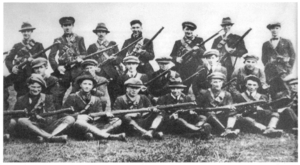Irish Republican Army facts for kids
The Irish Republican Army (IRA) was a group of Irish fighters. They wanted Ireland to be free from British rule. The IRA started from another group called the Irish Republican Brotherhood. They fought against the British Army in the Irish War of Independence. After this war, the island of Ireland was divided. The Republic of Ireland became independent. The IRA then split into different groups. Some of these groups were involved in fighting in Northern Ireland, known as "The Troubles." The original IRA is now also called Óglaigh na hÉireann.
Contents
The First IRA
The original Irish Republican Army (IRA) was formed after the Easter Rising in 1916. It brought together parts of the Irish Republican Brotherhood and the Irish Citizens Army. Their goal was to continue the fight for Ireland's freedom from Great Britain.
In 1919, the Irish Parliament declared Ireland independent. The IRA then fought against British control in the Irish War of Independence. This war ended in 1921 with the Anglo-Irish Treaty. This treaty divided Ireland into the Republic of Ireland and Northern Ireland.
The signing of this treaty caused a big split within the IRA. Some members supported the treaty, while others were strongly against it. This disagreement led to a difficult Irish Civil War. Friends and even family members found themselves fighting on opposite sides. The IRA group that opposed the treaty lost the civil war. However, the group did not disappear and continued its efforts against British rule.
The Troubles in Northern Ireland
In the 1930s, some parts of the IRA tried to unite Catholic and Protestant people in Northern Ireland. This was a challenging time.
The IRA became active again in the late 1960s. This happened because of harsh police actions against the civil rights movement in Northern Ireland. Also, groups called loyalist paramilitaries caused trouble. During this period, many Northern Irish Catholics felt unprotected by the law. They were often at the mercy of police forces and paramilitary groups supported by Britain.
IRA Groups Form
In the 1960s, there were disagreements within the IRA. Some members wanted to focus more on military actions. Others were interested in Marxist ideas and civil rights. This led to a split in 1969. The group divided into the Provisional Irish Republican Army (PIRA) and the "official" group (OIRA). The OIRA focused more on the civil rights movement. The "official" wing of the IRA never officially ended. However, it became much less active after 1980.
In the 1980s, younger activists from Northern Ireland took over leadership of the Provisional IRA. Gerry Adams became a key leader of Sinn Féin, a political party linked to the IRA. He moved the party more towards the left. In 1993, Gerry Adams worked with John Hume, a Social Democrat, to start a peace process. In August 1994, the IRA declared a ceasefire. This was a big step towards the Good Friday Agreement, a peace deal. Even with the ceasefire, the IRA remained active, though they stopped fighting.
End of the Conflict
Only two small groups continued fighting after the main IRA ceasefire. These were the Real IRA and the Continuity IRA. In August 1998, the Real IRA carried out a car bomb attack in Omagh, Northern Ireland. This tragic event resulted in the deaths of 29 people.
On July 28, 2005, the IRA announced the end of its armed campaign. A statement from the IRA said: "All IRA-Soldiers have been instructed to lay down their arms." It also added: "We believe that there is now an alternative way... to end British rule in our country." On September 26, 2005, the complete disarmament of the IRA was confirmed. This was announced by General John de Chastelain, who led the international disarmament commission. Two religious leaders, one Catholic and one Protestant, were present when the weapons were destroyed. No photos or videos were allowed as proof.
On October 29, 2005, Gerry Adams stated that the IRA's campaign had "clearly come to an end."
Images for kids
-
Flying Column No. 2 of the 3rd Tipperary Brigade of the Old IRA, photographed in 1921. Many groups calling themselves "Irish Republican Army" claim to be the rightful continuation of this original IRA.
See also
 In Spanish: IRA para niños
In Spanish: IRA para niños



